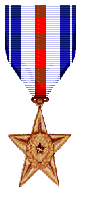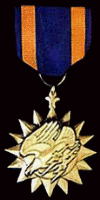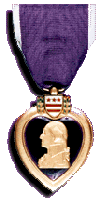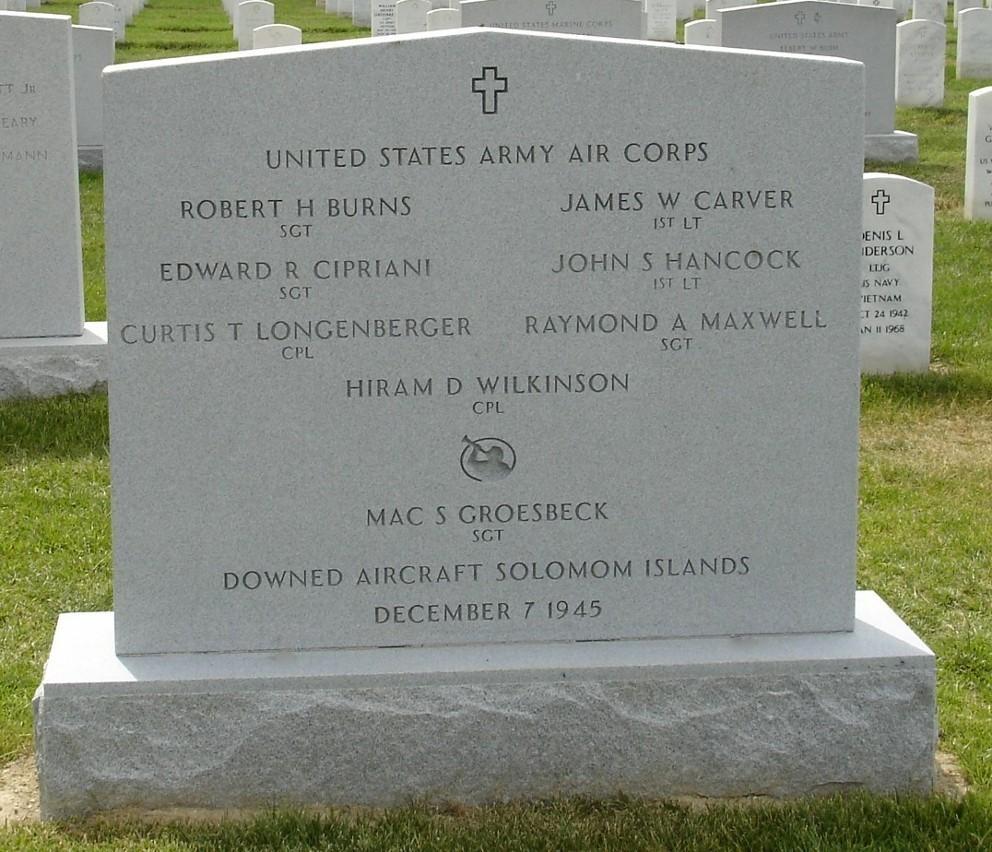- Missing WWII flier comes home at last
- 23 January 2005
- Carmina Danini
- Courtesy of the San Antonio Express-News
Until the day they died, Winnie Mae Carver and her husband, Ples Stell “Ike” Carver, believed that one day “Scootie,” their only son, would return home to Eagle Pass, Texas.
On November 7, 1942, they received a telegram from the War Department saying Second Lieutenant James Walter Carver’s plane was reported missing in action in the southwestern Pacific.
“They always said they were hopeful that maybe he was in a Japanese prisoner-of-war camp,” said Kathryn Cunningham, a resident of Quemado and Scootie Carver’s niece.
Ike Carver died in 1953; his widow in 1979.
More than 60 years after he disappeared, Scootie Carver is coming home. On Saturday, he will be buried at the foot of his mother’s grave in the family plot of the City Cemetery in Eagle Pass with full military honors and a flyover by jets from Laughlin AFB in Del Rio.
June Carver Hansen, his only remaining sibling and Cunningham’s mother, will not be able to attend. At 86, she suffers from a number of ailments, including glaucoma, and lives in a nursing home in Del Rio.
“When I told her he’d been found, my mom had a look of pure joy,” Cunningham said. “None of us ever expected it.”
Carver’s other sister, Margie Carver Hawkes, who lived in Midland, died in 2002.
The casket carrying Carver’s remains arrived at San Antonio International Airport on Saturday morning from Honolulu and was transported to Eagle Pass.
It’s a long journey from Papua New Guinea, where a villager searching for beetle nuts in 1998 discovered the wreckage of the long-lost American bomber plane.
The next year, a recovery team from the Joint POW/MIA Accounting Command in Hawaii took custody of the remains and artifacts found near the crash site. It would take a few more years before excavation and identification were completed.
Carver’s remains were identified through the use of mitochondrial DNA, from a blood sample taken from Cunningham.
Carver’s dog tags, navigation kit and cigarette lighter with his initials also were recovered by investigators.
Carver turned 22 just a few weeks before his plane disappeared while en route to Port Moresby, Papua New Guinea, after a night raid on Rabaul, a key base for the Japanese on New Britain Island.
Assigned to the 30th Bombardment Squadron (Heavy), 19th Bombardment Group, Carver was a navigator but substituted as co-pilot on what turned out to be his last flight.
“The regular co-pilot was sick and didn’t make the flight,” Cunningham said.
Seven other men, among them another Texan, were on board. Of those, the remains of only six were identified by JPAC’s Central Identification Laboratory.
The other pieces of bone were not large enough to be identified and will be buried later this year at Arlington National Cemetery. The headstone will bear the names of all the crew.
Carver was a sophomore majoring in petroleum engineering at Texas A&I College in Kingsville, now Texas A&M University-Kingsville, when he joined the Army Air Corps in January 1942.
Like most South Texas kids, he played football — he was co-captain of the team at Eagle Pass High School — and enjoyed hunting, fishing and roping.
To pay the tuition at A&I, Ike Carver sold Scootie’s horse, Ernesto.
“My mother says Scootie cried and told my grandfather, ‘But Daddy, I love Ernesto as much as you love Mama,'” Cunningham said.
Carver wanted to be a pilot, but the Army Air Corps needed navigators, and his background in math made him a perfect candidate.
Sent to navigation school at Mather Field in California, Carver graduated third in his class.
He was sent to Australia and assigned to a B-17, a heavy bomber known as the Flying Fortress.
Carver, who was promoted to First Lieutenant and awarded the Purple Heart while missing in action, flew about 19 missions before he was killed.
Letters and telegrams he sent home didn’t reflect much of what he was going through, but there were a few clues.
“I’m ready to come home and sleep in a good bed and take a bath every hour,” he wrote in one of the last letters his family received.
A ceremony honoring the crew will take place at Arlington National Cemetery on 28 April 2005.
Robert H. Burns
- Sergeant, U.S. Army Air Forces
- Service # 6999729
- 30th Bomber Squadron, 19th Bomber Group, Heavy
- Entered the Service from: Pennsylvania
- Died: November 7, 1942
- Missing in Action or Buried at Sea
- Tablets of the Missing at Manila American Cemetery
- Manila, Philippines
- Awards: Silver Star, Distinguished Flying Cross, Air Medal, Purple Heart
James W. Carver
- First Lieutenant, U.S. Army Air Forces
- Service # 0-725946
- 30th Bomber Squadron, 19th Bomber Group, Heavy
- Entered the Service from: Texas
- Died: November 7, 1942
- Missing in Action or Buried at Sea
- Tablets of the Missing at Manila American Cemetery
- Manila, Philippines
- Awards: Air Medal, Purple Heart
Edward R. Cipriani
- Sergeant, U.S. Army Air Forces
- Service # 13012501
- 30th Bomber Squadron, 19th Bomber Group, Heavy
- Entered the Service from: Pennsylvania
- Died: November 7, 1942
- Missing in Action or Buried at Sea
- Tablets of the Missing at Manila American Cemetery
- Manila, Philippines
- Awards: Air Medal, Purple Heart
Mac S. Groesbeck
- Sergeant, U.S. Army Air Forces
- Service # 19011114
- 30th Bomber Squadron, 19th Bomber Group, Heavy
- Entered the Service from: Utah
- Died: November 7, 1942
- Missing in Action or Buried at Sea
- Tablets of the Missing at Manila American Cemetery
- Manila, Philippines
- Awards: Distinguished Flying Cross, Air Medal, Purple Heart
John S. Hancock
- First Lieutenant, U.S. Army Air Forces
- Service # 0-417619
- 30th Bomber Squadron, 19th Bomber Group, Heavy
- Entered the Service from: Oklahoma
- Died: November 7, 1942
- Missing in Action or Buried at Sea
- Tablets of the Missing at Manila American Cemetery
- Manila, Philippines
- Awards: Silver Star with Oak Leaf Cluster, Purple Heart
Curtis T. Longenberger
- CORPORAL, U.S. Army Air Forces
- Service # 6890994
- 30th Bomber Squadron, 19th Bomber Group, Heavy
- Entered the Service from: Pennsylvania
- Died: November 7, 1942
- Missing in Action or Buried at Sea
- Tablets of the Missing at Manila American Cemetery
- Manila, Philippines
- Awards: Air Medal, Purple Heart
Raymond A. Maxwell
- Sergeant, U.S. Army Air Forces
- Service # 18037760
- 30th Bomber Squadron, 19th Bomber Group, Heavy
- Entered the Service from: Texas
- Died: November 7, 1942
- Missing in Action or Buried at Sea
- Tablets of the Missing at Manila American Cemetery
- Manila, Philippines
- Awards: Air Medal, Purple Heart
Hiram D. Wilkinson
- CORPORAL, U.S. Army Air Forces
- Service # 16014049
- 30th Bomber Squadron, 19th Bomber Group, Heavy
- Entered the Service from: Michigan
- Died: November 7, 1942
- Missing in Action or Buried at Sea
- Tablets of the Missing at Manila American Cemetery
- Manila, Philippines
- Awards: Air Medal, Purple Heart
Michael Robert Patterson was born in Arlington and is the son of a former officer of the US Army. So it was no wonder that sooner or later his interests drew him to American history and especially to American military history. Many of his articles can be found on renowned portals like the New York Times, Washingtonpost or Wikipedia.
Reviewed by: Michael Howard










